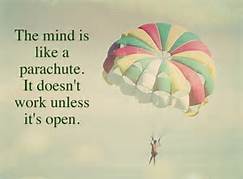
On our life journey, we will face many challenges. Some may be easy to overcome; others may test every fiber of our being in attempting to overcome them. And then there are those that seem so overwhelming that we become paralyzed and unable to do anything. We need to be careful of anything that paralyzes us because as Edwin Lewis Cole (founder of the Christian Men’s Network) shares, “You don’t drown by falling in the water. You drown by staying there.” This sage advice is a great reminder that it isn’t our challenges that defeat us (falling in the water), but rather our inability to come up with an unconventional, unique, resourceful, divergent solution to the challenge (just staying put in the water).

When faced with a challenge that seems insurmountable, we need to tap into our ingenious self so we can be inventive, creative, and divergent in coming up with a way, with a solution, to move us “out of the water.” Thinking outside the box is a way to think differently; to think unconventionally, creatively, and divergently. Thoughts outside the box help us view things from a different perspective. If we view challenges in traditional ways, we might easily give up dealing with the challenge if we get the least bit overwhelmed. Often when we “climb out of the box,” we are able to see more; many possible solutions or directions may emerge. It is definitely easier to put things into a different perspective when our view isn’t the “same four walls.”

The following story is a wonderful example of how outside the box thinking helped in dealing with what seemed to be an impossible situation:
In a small Italian town, hundreds of years ago, a small business owner owed a large sum of money to a loan-shark. The loan-shark was a very old, unattractive-looking guy that just so happened to fancy the business owner’s daughter. He decided to offer the businessman a deal that would completely wipe out the debt he owed him. However, the catch was that we would only wipe out the debt if he could marry the businessman’s daughter. Needless to say, this proposal was met with a look of disgust.

The loan-shark said that he would place two pebbles into a bag, one white and one black. The daughter would then have to reach into the bag and pick out a pebble. If it was black, the debt would be wiped, but the loan-shark would then marry her. If it was white, the debt would also be wiped, but the daughter wouldn’t have to marry the loan-shark.

Standing on a pebble-strewn path in the businessman’s garden, the loan-shark bent over and picked up two pebbles. While he was picking them up, the daughter noticed that he’d picked up two black pebbles and placed them both into the bag. He then asked the daughter to reach into the bag and pick one.

The daughter naturally had three choices as to what she could have done:
- Refuse to pick a pebble from the bag.
- Take both pebbles out of the bag and expose the loan-shark for cheating.
- Pick a pebble from the bag fully well knowing it was black and sacrifice herself for her father’s freedom.

She drew out a pebble from the bag, and before looking at it ‘accidentally’ dropped it into the midst of the other pebbles. She said to the loan-shark, “Oh, how clumsy of me. Never mind, if you look into the bag for the one that is left, you will be able to tell which pebble I picked.”

The pebble left in the bag is obviously black, and seeing as the loan-shark didn’t want to be exposed, he had to play along as if the pebble the daughter dropped was white, and clear her father’s debt.

This story illustrates how is it possible to overcome a challenge, a tough situation, using out-of-the box thinking rather than give in to the only options we think we have to pick from. So, on our life journey, the next time a challenge crosses our path, we need to pause and strategize by:
PRACTICING KALEIDOSCOPIC THINKING. Take all the pieces for the situation and play with arranging them in different configurations.

PUTTING ON A CRITICAL THINKING CAP. When one thinks critically, the situation is analytically evaluated. This helps with bringing out different points of view related to the situation.

USING ‘PARACHUTE THINKING.’ Parachutes only work when they are open. In using out-of-the-box thinking, keep an open mind and be willing to change it based on a range of options.

GIVING OURSELVES THE ‘THIRD DEGREE.’ Ask: Is there another way to get what I want? Is the desired result really the best result? Who else has information that might help me? What is something very similar to what I need that might also work? Who is the expert in this area? What is one more thing I can try? Is there more than one way to look at or deal with the issue? What would someone I admire do in this same situation?

CREATING A MIND MAP. This is a diagram that visually outlines thoughts. A single word is placed in the center (the challenge we are facing). Feelings, thoughts, ideas, and ways to deal with the issue are written as offshoots from the center. This is a nice way to organize and summarize thoughts. Sometimes a solution to an issue clearly emerges from this process.

Thinking outside the box is a way of thinking that questions and challenges prevailing thought and opens us up to numerous solutions rather than just the way something has always been done. When we think outside the box, we are creative; we use our imagination. Outside the box thinking may be just what it takes to propel us beyond the challenge, just as it did the businessman’s daughter in the story. So, when facing a challenge in 2020, take some time to do a little out-of-the-box thinking in coming up with a way to overcome the challenge.







